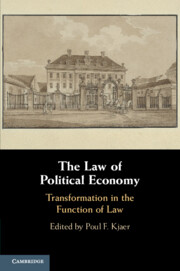Book contents
- The Law of Political Economy
- The Law of Political Economy
- Copyright page
- Dedication
- Contents
- Contributors
- Acknowledgements
- Abbreviations
- 1 The Law of Political Economy
- Part I Studying the Law of Political Economy
- Part II Transformations of the Law of the Globalising Economy
- Part III The Transformation of the Law of Political Economy in Europe
- Part IV Towards a New Law of Political Economy
- 12 The Future of Law – ‘Serial Law’?
- 13 After Governance?
- 14 The Transnational Dimension of Constitutional Rights
- 15 Counter-Rights
- Index
14 - The Transnational Dimension of Constitutional Rights
Framing and Taming ‘Private’ Governance beyond the State*
from Part IV - Towards a New Law of Political Economy
Published online by Cambridge University Press: 18 April 2020
- The Law of Political Economy
- The Law of Political Economy
- Copyright page
- Dedication
- Contents
- Contributors
- Acknowledgements
- Abbreviations
- 1 The Law of Political Economy
- Part I Studying the Law of Political Economy
- Part II Transformations of the Law of the Globalising Economy
- Part III The Transformation of the Law of Political Economy in Europe
- Part IV Towards a New Law of Political Economy
- 12 The Future of Law – ‘Serial Law’?
- 13 After Governance?
- 14 The Transnational Dimension of Constitutional Rights
- 15 Counter-Rights
- Index
Summary
International law often fails to regulate cross-border affairs due to a lack of consent or pace among the states. As a consequence, transnational governance arrangements, which are established by contract mainly among non-state actors, step in to fill the gap. The arrangement that allocates domains on the Internet offers the most sophisticated example to date. This chapter argues that a new approach to the horizontal effect of constitutional rights may both account for the emergence of such arrangements and offer a solution to the problem of their legitimacy. According to this understanding, constitutional rights at the same time enable and restrict transnational regulation. In this way, they guarantee a comprehensive protection of freedom under conditions of globalisation. As long as transnational governance arrangements are not able to generate constitutional rights of their own, however, the national legal orders must complement them. Hence, the legitimacy of law in world society may only be ensured through a dialectical process of internal and external constitutionalisation, resulting from the interaction of its various constituents.
Keywords
- Type
- Chapter
- Information
- The Law of Political EconomyTransformation in the Function of Law, pp. 348 - 371Publisher: Cambridge University PressPrint publication year: 2020



